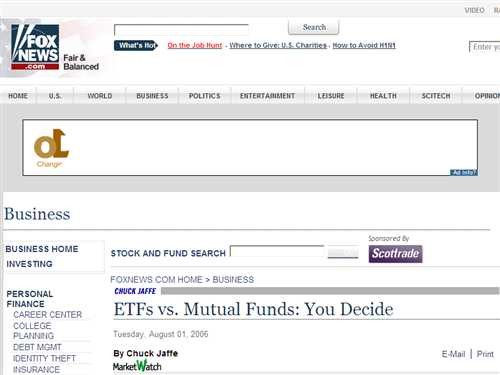Own the Market With Index Funds and ETFsKiplinger
Post on: 25 Июнь, 2015 No Comment

They’re cheap and beat most actively managed funds. What’s not to like?
EDITOR’S NOTE: This article is from Kiplinger’s Mutual Funds 2008 special issue. Order your copy today .
Beating the market’s return consistently is a very hard thing to do, and that’s why we celebrate the handful of mutual-fund and hedge-fund managers who manage to do it. But we can—and do—get carried away with the idea of beating the market. Studies show that having the right mix of stocks, bonds and other types of investments in your portfolio adds far more to your return than stock picking.
That’s why index funds make a lot of sense. Index funds simply track broad swaths of the market, and they don’t try to pick the best stocks. For example, Standard & Poor’s 500-stock index tracks the largest 500 public companies in the U.S. The Russell 2000 covers 2000 small-company U.S. stocks. Index funds’ close cousins are exchange-traded funds. These also track broad swaths of stocks or other investments, but they trade like stocks. For use in a long-term portfolio, consider index funds and ETFs interchangeable.
Over the long run, a well-diversified index portfolio gives most investors a better return than a comparable portfolio full of funds run by highly paid portfolio managers. A key reason is expenses. The average annual expense ratio for a non-indexed U.S. stock fund is 1.4%. Many index funds cost less than half that much. And that does not include other costs—such as trading commissions and taxes, both of which tend to be lower for index funds—that are not included in the expense ratio. Index funds are also generally tax-efficient because trading is kept to a minimum.
Advertisement
Does that mean you should tell all fund managers to get lost and own only index funds? Maybe. We see the benefits of both an all-index-fund portfolio and a portfolio made up exclusively of actively managed funds, and even a portfolio made up of both types of funds. Which you choose depends largely on your attitude toward investing.
If you don’t mind monitoring individual funds and making changes when necessary, you may want to go with actively managed funds—though it takes time and discipline. For such investors we have compiled a list of funds run by managers with solid track records of outperforming their benchmarks (see The 25 Best Mutual Funds ). Or you may choose to go with an index-fund portfolio because you don’t need to monitor the funds as closely and because their solid, no-hassle performance is enough to meet your goals.
Ten years ago, it would have been almost impossible to go wrong by buying an index fund, as long as you stuck to major categories (such as small-company stocks) and low-cost providers. Today, things are not so simple. The explosion in ETFs—the number of funds has doubled since early 2006 to more than 500—has littered the market with a lot of options you can do without. For example, do you really need the Healthshares Dermatology and Wound Care fund or CurrencyShares Swedish Krona Trust? We think not. To be fair, these highly specialized ETFs and many others like them were created primarily for hedge-fund managers and other professional investors. But they can be purchased by anyone.
Even if you’re looking for something relatively simple, the number of choices can be dizzying. How do you choose the right fund? Here are some simple rules to follow to find an index fund or ETF that’s right for you.
Stick to indexes with a broad focus
ETFs or indexes that cover a large segment of the market, such as U.S. large-company stocks, foreign stocks and commodities, are good core holdings. While even a big slice of the market can fall out of favor now and then, the sheer number of holdings in a broad index can limit the damage.
The proliferation of narrowly focused funds that invest in such things as water utilities and nanotechnology makes it easy—too easy—to get sidetracked into fad investing. And doing so can be bad for your portfolio’s health. Buying a narrowly focused ETF is like placing a big bet. For example, the 22 stocks (most of them biotech companies) in the Healthshares Dermatology and Wound Care fund (symbol HRW) represent a tiny slice of the $19-trillion value of all U.S. stocks. Even if you allot just 5% of the U.S. stock portion of your portfolio to this fund, you are overweighting these stocks by a very large magnitude.

Of course, if you feel strongly that dermatology and wound-care stocks are ready to skyrocket, go ahead and buy the ETF. Maybe it will turn out to be a good bet. But buying a broader-based ETF—such as Health Care Select Sector SPDR (XLV ), which tracks 54 S&P 500 stocks with a total market value of $1.6 trillion, or SPDR S&P Biotech fund (XBI ), which holds a much broader array of biotech firms—is a safer way to make such a bet.
In general, sector ETFs can be a good idea for a small portion of your portfolio (between 5% and 10%). Stick to broad sectors, though, such as energy, technology or health care.
Always keep costs in mind
When it comes to indexing, the expense ratio is the biggest factor in separating winners from losers. The E*Trade S&P 500 Index fund (ETSPX ), for example, charges just 0.09% annually for expenses, and its annualized return over five years to December 1, 2007, is 11.4%. The Dreyfus S&P 500 index fund (PEOPX ) costs more than five times as much — 0.50% annually — and not surprisingly, it has produced a smaller five-year return (11.1%). The difference may seem insignificant, but for a $10,000 portfolio, the cheaper fund puts $1,000 more into your pocket over ten years.
Keep other expenses in mind as well. ETFs trade like stocks, and you must pay a commission to buy and sell shares. If you plan to make regular purchases, you may be better off buying an indexed mutual fund.
Simple indexing strategies are best
Traditionally, index investing has been a relatively low-risk and low-cost way of buying a set of stocks and sticking with them through thick and thin. That’s still the right strategy. But financial engineers have cooked up new ways of constructing indexes, based on a stock’s dividend payments (the WisdomTree family of ETFs); a variety of so-called fundamental factors, such as sales and book value (RAFI indexes); or changing economic conditions (PowerShares Intellidexes). ETFs that track these New Age indexes buy and sell stocks much more frequently than traditional index funds do. That increases costs, and it’s not clear that you get better returns as a result.














